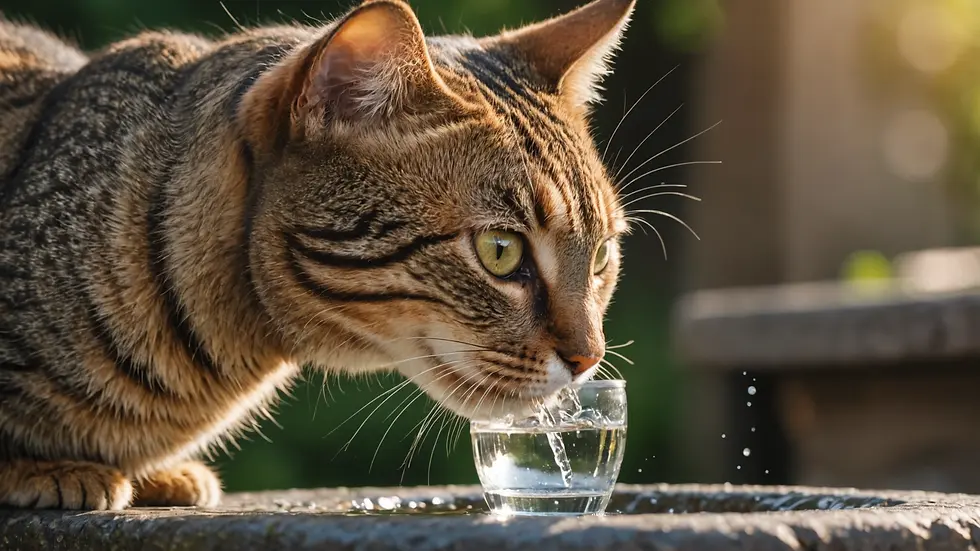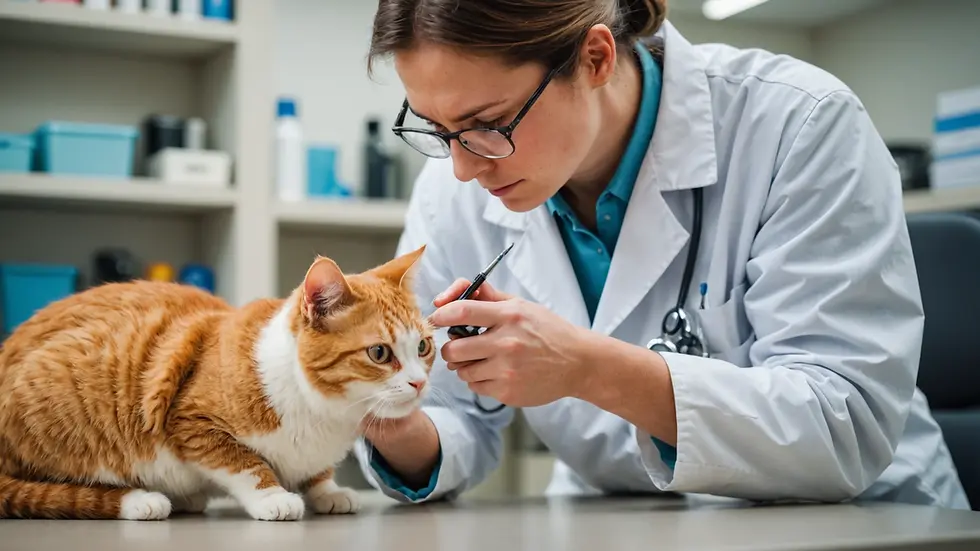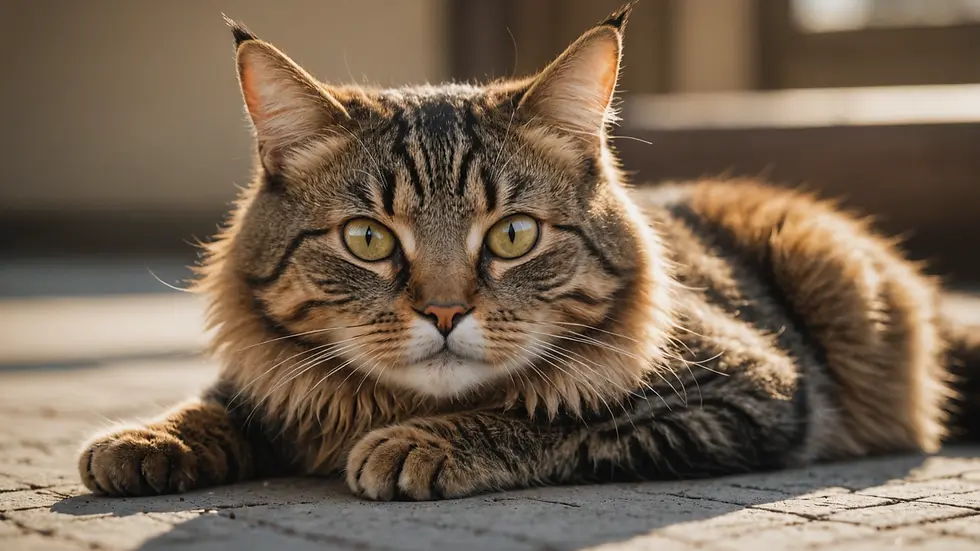Cracking the Code: Understanding the Enigma of Feline Diabetes
- Jyotiraj Borah
- Feb 7
- 4 min read
Diabetes mellitus is a common health problem in cats that can lead to serious complications if not addressed. For cat owners, understanding this condition is essential for early diagnosis and effective treatment. In this post, we will explore the signs of feline diabetes, management strategies, and the vital role of regular veterinary check-ups.
What is Feline Diabetes?
Feline diabetes primarily occurs when a cat's body cannot use glucose properly, either due to insufficient insulin production or insulin resistance. The two main types of diabetes in cats are:
Type I Diabetes: This is less common in cats and happens when the pancreas does not produce enough insulin.
Type II Diabetes: This is more frequently seen in cats, especially those who are overweight. In this type, the body becomes resistant to insulin. Studies show that about 80% of diabetic cats are overweight, underscoring the link between obesity and diabetes.
Knowing the differences between these types helps veterinarians tailor the best treatment plans for each cat.
Signs of Feline Diabetes
Identifying diabetes early can significantly impact a cat’s quality of life. Here are key signs to watch for:
Increased Thirst (Polydipsia)
If you notice your cat drinking more water than before, it can indicate diabetes. High blood glucose levels lead to increased urination, causing your cat to drink more to stay hydrated. For instance, a diabetic cat might drink up to 1-2 cups of water daily, compared to the usual 0.5 cups.
Increased Urination (Polyuria)
A rise in water intake results in more frequent trips to the litter box. You may observe that your cat has soaking wet bedding or that you need to change the litter box more often.
Increased Appetite (Polyphagia)
Despite having a normal or even heightened appetite, a diabetic cat can lose weight. This happens because insulin is necessary for processing glucose. When insulin is low, the body resorts to burning fat for energy.
Weight Loss
Weight loss, even with increased food intake, is a classic indicator of diabetes. It’s not uncommon for a diabetic cat to lose 1-2 pounds rapidly. Keep an eye out, as this can lead to serious health issues.
Lethargy
A lack of energy or noticeable fatigue is common among diabetic cats. If your once-active cat prefers lying around or shows less enthusiasm, it may be time for a vet visit.
Poor Coat Condition
Diabetes can lead to a dull and unkempt coat. The inability to properly metabolize glucose may cause skin issues as well, resulting in discomfort or irritation for your cat.
Unusual Behavior
Changes in behavior, such as increased irritability or withdrawal from social interaction, may be signs of diabetes. Keeping track of your cat's mood and interactions can help identify changes.
Promptly observing these signs and consulting your veterinarian can help secure an accurate diagnosis and timely care.

Diagnosing Feline Diabetes
Diagnosis of feline diabetes typically involves several steps, including:
Blood Tests: A vet will check for high glucose levels in your cat's blood. Fructosamine levels may also be assessed to gauge long-term glucose control.
Urinalysis: A urine sample will be tested for sugar and ketones, which are indicators of diabetes.
Health History: Your vet will analyze your cat’s health history, behavioral changes, and clinical signs to make a well-informed diagnosis.
Early diagnosis and treatment are crucial. Regular veterinary visits play a key role in managing your cat’s health.
Treatment Options for Feline Diabetes
Effective management of diabetes in cats usually includes the following:
Insulin Therapy
Most diabetic cats will require daily insulin injections. The type and dosage depend on your cat’s individual needs. Proper insulin therapy can lower blood sugar levels and improve your cat's health dramatically.
Diet Management
Your vet may recommend a high-protein, low-carbohydrate diet to help control blood sugar levels. Research suggests that such diets can reduce blood glucose levels by 20–30% in overweight diabetic cats. Following prescribed meal plans, portion control, and feeding schedules are critical.
Weight Management
For obese cats, gradual weight loss is often essential to increasing insulin sensitivity. Even a 10% reduction in body weight can lead to notable improvements in diabetes management. Some cats may even reach remission with effective weight control.
Regular Monitoring
Monitoring blood glucose levels at home with a glucometer is important. This will help you manage your cat’s diabetes more effectively between veterinary visits, which should remain frequent for treatment adjustments.
Successful management of feline diabetes depends on teamwork between you and your veterinarian to ensure the best outcomes for your cat.

Caring for Your Diabetic Cat
Creating a conducive environment for your diabetic cat involves some adjustments. Here are ways to improve their lifestyle:
Establish a Routine
Set consistent feeding and insulin schedules to help stabilize blood sugar levels. Routine is crucial in managing diabetes effectively.
Monitor Behavior
Keep a close eye on your cat’s daily habits. Note any changes in appetite or activity levels, and share this information with your vet.
Maintain a Comfortable Environment
Creating a calm and caring home can help reduce stress, which is beneficial for managing diabetes. Stress can cause glucose levels to spike.
Educate Yourself
Knowledge about feline diabetes empowers you to provide better care. Leverage resources like books or online forums to learn more about managing the condition. Networking with other pet owners can offer valuable support.
Final Thoughts
Feline diabetes can be effectively managed with awareness and the right support. Recognizing symptoms early and collaborating with your veterinarian to develop a treatment strategy are essential.
If your cat shows signs of diabetes, don’t hesitate to schedule a vet consultation. Commitment to treatment and open communication with your vet can lead to a successful management plan. With care and diligence, you can ensure your furry friend lives a healthier life.

By understanding feline diabetes, you're taking the first step toward providing the best care for your beloved pet, ensuring they remain a cherished part of your life for years to come.




Comments